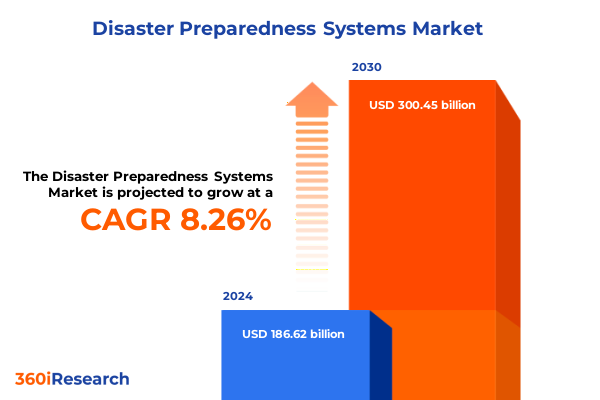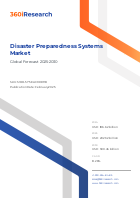The Disaster Preparedness Systems Market size was estimated at USD 186.62 billion in 2024 and expected to reach USD 202.32 billion in 2025, at a CAGR 8.26% to reach USD 300.45 billion by 2030.

Introduction to the Evolving Disaster Preparedness Ecosystem
In an era marked by unprecedented natural calamities and man-made emergencies, understanding the frameworks and strategies behind disaster preparedness has never been more critical. Today, the global community demands systems that not only respond quickly but also adapt to the rapidly changing risks posed by climate change and urbanization. This report explores the intricate ecosystem of disaster preparedness systems, offering a deep dive into the innovative measures that organizations across the spectrum adopt to safeguard lives, assets, and infrastructure. Key factors such as emerging technologies, regulatory mandates, and shifting market demands are analyzed to provide decision-makers with a clear picture of where the industry stands and where it is headed. With a focus on strategy and operational excellence, the examination presented here leverages cutting-edge research methods and current data to unearth opportunities that can transform preparedness and resilience. As industries and governments move towards more proactive and integrated approaches, the report sets the stage for a comprehensive discussion on the evolving landscape of disaster management and emergency response, making it an indispensable resource for experts and leaders alike.
Transformative Shifts in Disaster Preparedness and Response Systems
Recent years have witnessed a profound transformation in how disaster preparedness and emergency response systems are structured and implemented. Technological advancements, such as the integration of cloud computing, real-time data analytics, and sophisticated communication networks, have revolutionized response times and accuracy. Moreover, the shift from reactive to proactive disaster management is evident as stakeholders deploy systems that emphasize early detection, swift intervention and comprehensive post-event analysis. The continuous evolution of risk assessment methodologies, driven by big data and machine learning, enables organizations to predict potential threats with greater confidence. Collaborative ventures between public institutions and private enterprises further reflect this transformative trend, as they collectively modernize legacy systems that were once cumbersome and inflexible. This transformative journey is fueled by ongoing investments in hardware innovation, software enhancements, and service-driven models that together create an agile and resilient ecosystem. As decision-makers adopt these cutting-edge innovations, the landscape moves towards more streamlined, integrated, and user-centric systems that are essential for managing today’s complex challenges.
Market Segmentation Insights Driving Strategic Decision-making
A nuanced exploration of market segmentation reveals a multifaceted structure underlying the disaster preparedness systems landscape. From a type perspective, the market has been analyzed across domains such as Disaster Risk Management Systems, Early Warning Systems, Emergency Communication Systems, Incident Management Systems, Safety Management Systems, and Surveillance Systems, each contributing distinct functionalities in crisis scenarios. In terms of component analysis, the emphasis is laid on Hardware, Services, and Software, where Hardware is further divided into Communication Devices and Surveillance Equipment. The service segment is elaborated upon through Consulting Services, Technical Support Services, and Training and Education, which are pivotal in ensuring the seamless integration and implementation of these systems. Application-based segmentation examines the strategies deployed against Man-Made Disasters, Natural Disasters, and Public Health Emergencies, while end-user analysis categorizes the market into Corporate Entities, Government and Non-Governmental Organizations, and Healthcare Facilities. Within the corporate domain, deeper insights emerge when considering Offices and Retail Outlets specifically. Additionally, deployment strategies have been studied from the perspectives of Cloud-Based solutions versus On-Premises implementations, offering a comprehensive view that aligns operational needs with emerging technological trends.
- Type
- Component
- Application
- End User
- Deployment
Regional Market Dynamics and Emerging Trends
The regional dynamics of disaster preparedness systems reveal that distinct geographical areas are witnessing varied growth trajectories and innovation markers. In the Americas, a combination of robust infrastructure investments and stringent regulatory frameworks has fostered a vibrant market, where both public and private sectors work hand in hand to modernize emergency response protocols. Across Europe, the Middle East, and Africa, the market is characterized by a mix of advanced technological developments interlaced with unique challenges stemming from regional socio-economic conditions. Strategic initiatives in these regions often focus on integrating legacy systems with modern digital solutions to enhance readiness and response efficiency. Meanwhile, the Asia-Pacific region stands out as a hotbed for technological innovation, where rapid urbanization and frequent natural catastrophes drive a continuous evolution in disaster management practices. The interplay of governmental policy reforms, burgeoning technological adoption, and increased private sector participation in these locales spotlights a trend towards building more resilient infrastructures and agile response systems. These regional insights offer a clear roadmap for how global trends and localized needs converge to shape the future of disaster preparedness.
- Americas
- Asia-Pacific
- Europe, Middle East & Africa
Leading Enterprises Shaping the Market Landscape
The disaster preparedness market is influenced by a constellation of key players whose expertise and innovation continue to drive industry standards. Notable enterprises such as 11:11 Systems Inc. and 3M Company deliver comprehensive solutions that merge technology with practical risk management strategies. Alert Technologies Corporation and Alertus Technologies LLC have carved out substantial niches by offering specialized early warning and emergency communication services, while technology giants such as Amazon Web Services, Inc. and Google LLC by Alphabet Inc. bring the power of cloud and big data analytics to the forefront. Established entities like Atos SE, BlackBerry Limited, and Broadcom Inc. reinforce the market through their in-depth technical prowess and global reach. Additional market leaders including CHR Solutions, Druva Inc., Eaton Corporation PLC, and ESRI expand the ecosystem by focusing on robust and scalable components. Companies such as Everbridge, Inc and GeoSIG Ltd. combine expert-driven insights with operational excellence, while industry innovators such as Hagerty Consulting Inc., Haystax Technology by Fishtech LLC, and Hewlett Packard Enterprise Company consistently push the envelope in system integration and performance. The interplay between these various market giants, including Hexagon AB, Honeywell International Inc., ICF International, Inc., and International Business Machines Corporation, solidifies the foundation of an industry determined to transform disaster preparedness and recovery.
- 11:11 Systems Inc.
- 3M Company
- Alert Technologies Corporation
- Alertus Technologies LLC
- Amazon Web Services, Inc.
- Atos SE
- BlackBerry Limited
- Broadcom Inc.
- CHR Solutions
- Druva Inc.
- Eaton Corporation PLC
- ESRI
- Everbridge, Inc
- GeoSIG Ltd.
- Google LLC by Alphabet Inc.
- Hagerty Consulting Inc.
- Haystax Technology by Fishtech LLC
- Hewlett Packard Enterprise Company
- Hexagon AB
- Honeywell International Inc.
- ICF International, Inc.
- International Business Machines Corporation
- Japan Radio Co., Ltd. by Nisshinbo Holdings Inc.
- Johnson Controls International PLC
- Juvare, LLC
- Kenyon International Emergency Services
- Lockheed Martin Corporation
- Microsoft Corporation
- Motorola Solutions, Inc.
- NEC Corporation
- OnSolve
- Open Text Corporation
- Oracle Corporation
- Resolver Inc. by Kroll, LLC
- Rolta India Limited
- RTX Corporation
- Samsung Electronics Co., Ltd.
- SeismicAI Ltd.
- Siemens AG
- Singlewire Software, LLC
- Telegrafia, a.s.
- TRUSTIA Corporation
- Veoci Inc.
Strategic Recommendations for Market Innovation and Resilience
For industry leaders contemplating their next strategic move, several actionable recommendations emerge from the current market dynamics and technological trends. First, it is essential to invest in research and development to foster innovation across hardware, software, and service delivery. This not only enhances the agility of disaster response systems but also offers a competitive edge in the fast-evolving market. Leaders should consider forming strategic partnerships and collaborative ventures that blend the strengths of various industry actors, thereby optimizing resource allocation and accelerating implementation cycles. Moreover, leveraging advanced analytics and machine learning can refine risk assessment and enable proactive system adjustments before disasters occur. Emphasizing multi-layered training and continuous upskilling of personnel ensures that the human element remains robust against emerging threats. Simultaneously, testing system resilience through simulated disaster scenarios can highlight operational gaps and drive process improvements. Finally, adopting flexible deployment strategies, especially those that incorporate cloud-based solutions alongside traditional on-premises infrastructure, allows organizations to tailor their response based on immediate needs and long-term scalability. These recommendations collectively form a blueprint for innovation, ensuring preparedness systems remain effective in the face of an unpredictable global landscape.
Ask ResearchAI anything
World's First Innovative Al for Market Research
Conclusion and Forward-Looking Perspectives
The evolving landscape of disaster preparedness systems clearly signals a critical juncture where technology, strategic planning, and collaborative efforts converge to redefine how communities manage crises. A closer inspection of market segments, regional trends, and the dynamic interplay among key industry players reveals that the future of emergency response will be underpinned by rapid innovation and adaptive strategies. As organizations recalibrate their approaches to accommodate an increasingly complex array of risks—from natural disasters to man-made emergencies—the imperative to build robust, resilient systems grows stronger by the day. The insights presented here serve as a testament to the ongoing commitment across sectors to safeguard lives, infrastructure, and economies against unpredictable events. In drawing together diverse data points and strategic initiatives, it is evident that forward-looking investments in technology and human capital are essential. As the international community continues to prioritize disaster preparedness, the need for agile, integrated systems becomes ever more pertinent, setting the stage for a new era of proactive risk management that underscores the value of strategic foresight and operational excellence.
- Preface
- Research Methodology
- Executive Summary
- Market Overview
- Market Insights
- Disaster Preparedness Systems Market, by Type
- Disaster Preparedness Systems Market, by Component
- Disaster Preparedness Systems Market, by Application
- Disaster Preparedness Systems Market, by End User
- Disaster Preparedness Systems Market, by Deployment
- Americas Disaster Preparedness Systems Market
- Asia-Pacific Disaster Preparedness Systems Market
- Europe, Middle East & Africa Disaster Preparedness Systems Market
- Competitive Landscape
- List of Figures [Total: 27]
- List of Tables [Total: 396 ]
Contact Ketan Rohom for Exclusive Market Insights
For those seeking to gain an in-depth view of the disaster preparedness systems market, direct consultation with seasoned experts offers unparalleled value. Ketan Rohom, Associate Director of Sales & Marketing, invites industry stakeholders to explore this comprehensive report that uncovers critical market drivers, segmentation details, regional dynamics, and competitive insights. By connecting with Ketan, you can access actionable intelligence that not only demystifies complex trends but also equips you to make well-informed strategic decisions. Take the next step to enhance your market perspective and empower your organization with data-driven insights that can transform your approach to disaster preparedness. Reach out now to unlock a wealth of knowledge designed to accelerate growth, fortify resilience, and deliver a competitive advantage in an ever-changing global landscape.

- How big is the Disaster Preparedness Systems Market?
- What is the Disaster Preparedness Systems Market growth?
- When do I get the report?
- In what format does this report get delivered to me?
- How long has 360iResearch been around?
- What if I have a question about your reports?
- Can I share this report with my team?
- Can I use your research in my presentation?




